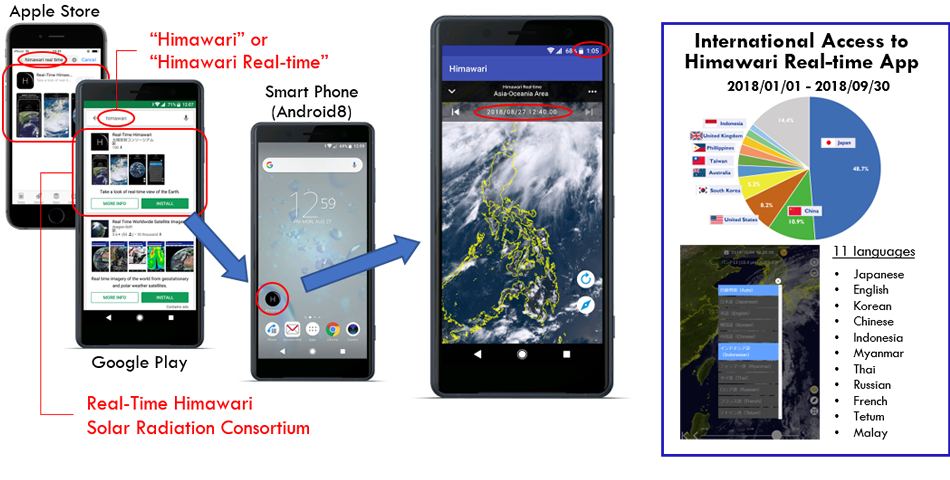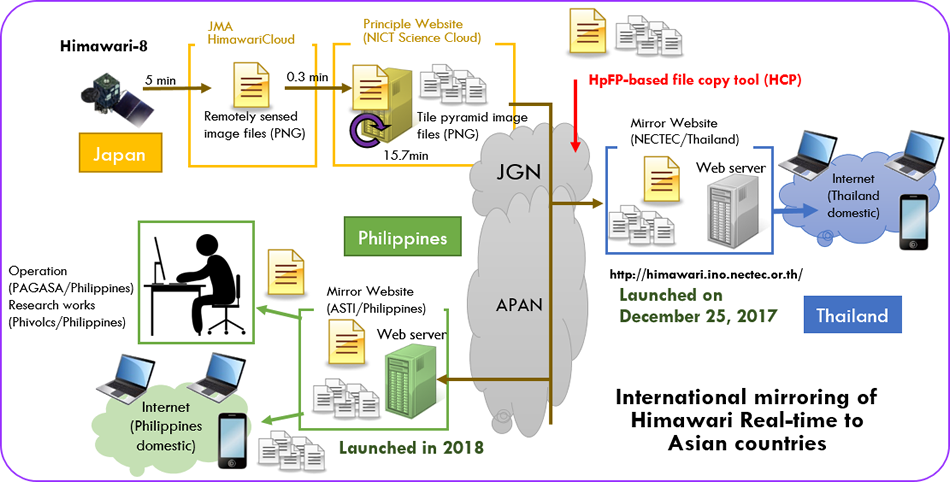1. Asiapacific-Europe Ring
In July 2019, Eight(8) R&E network organizations, NICT (Japan), AARNet (Australia), GÉANT (Europe), NII (Japan), NORDUnet (European Nordics), SingAREN (Singapore), SURF (The Netherlands) and TEIN*CC (Asia-Pacific), have signed a Memorandum of Understanding (MOU) at the 6th Asi@Connect Project Meeting in Putrajaya, Malaysia. The MOU is for the collaboration to run 100 gigabit per second network between Asia and Europe. The MOU partners agreed to contribute their own 100Gbps link to create a resilient system, called Asiapacific-Europe Ring (AER) . NICT is collaborated with 100Gbps link between Tokyo-Hong Kong-Singapore.
<AER>
https://www.nict.go.jp/en/info/topics/2019/07/22-1.html
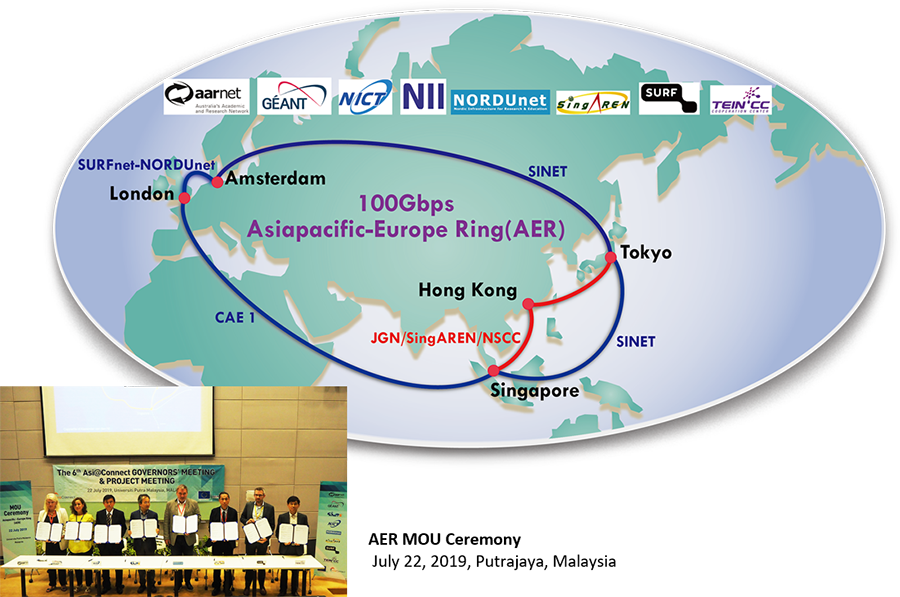
2. Asia Pacific Oceania Network (APOnet) Collaboration
In June 2021, 11 global leading-edge Research and Education networks, which are NICT, AARNet, ARENA-PAC, Internet2, KISTI, NII, Pacific Wave, REANNZ, SingAREN, TransPAC, and UH, signed a Memorandum of Understanding to join the Asia Pacific Oceania network (APOnet) .
APOnet is an enhancement of APR (Asia-Pacific Ring), which was signed in December 2017 and ended in November 2020. To seven organizations and networks under APR, four organizations and networks were newly added to APOnet.
APOnet will create a production quality high-speed trans-oceanic network services delivery system that is more flexible and resilient, to support the development of collaboration and sharing of scientific instruments and data within research and education in East Asia, Southeast Asia, Oceania, and North America.
APOnet’s Eight Main Activities:
- 1. Supporting highly available connectivity
- 2. Backup traffic
- 3. Cooperation and coordination
- 4. Network research and services
- 5. Application development and support
- 6. External experiment support
- 7. Preferred route identification and resolution
- 8. Sharing of measurement data
<APOnet> https://www.aponet.global/
<NICT Events & Topics>
https://www.nict.go.jp/en/info/topics/06/17-1.html

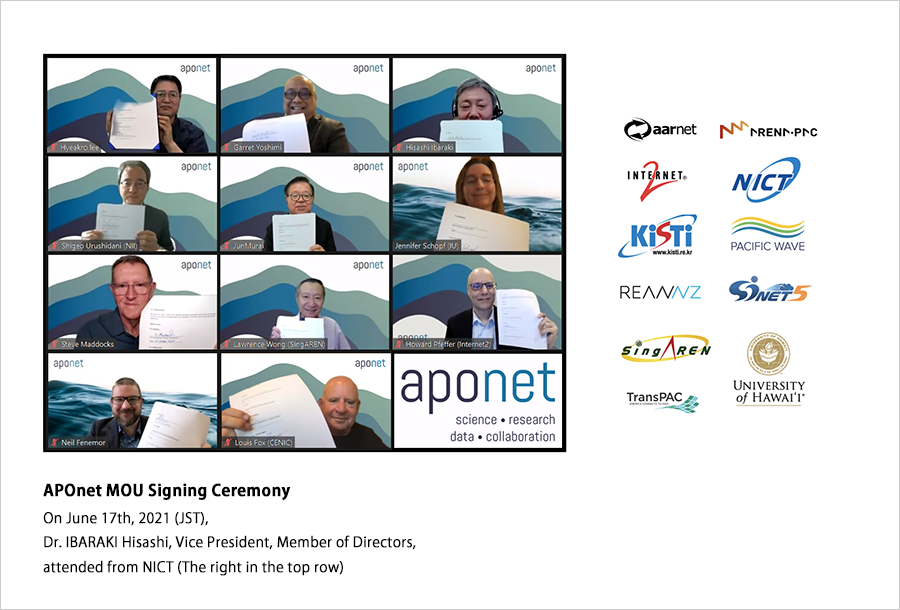
3. Support for LHCONE
LHCONE (Large Hadron Collider Open Network Environment) is to ensure better access to the most important datasets by the worldwide HEP (High Energy Physics) community and improve data analysis.
<LHCONE>
https://twiki.cern.ch/twiki/bin/view/LHCONE/WebHome
JGN provides links for LHC Information Exchange between Asia and other regions.
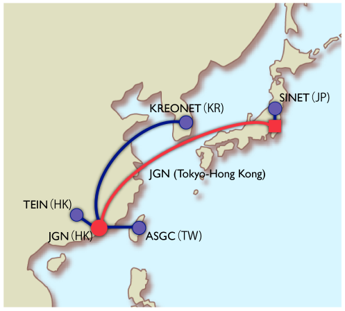
- JGN started the operation of LHCONE router at Hong Kong
- Big science is a driving force of next-gen ICT infrastructure
- Under the collaboration with SINET, JGN supports LHCONE between Japanese and Asian academic organizations
- JGN established peering with SINET, KREONET, ASGC, and TEIN-HK
- JGN provides L3 networking for LHCONE with this router, not L2 tunnels
- Only the routing information related to those organizations are exported
- L2 at HK is provided by HKIX
4. "Himawari" project on APAN/JGN
The Himawari Satellite Project is aiming to develop and demonstrate the information and communication technology through the distributed archives and publicly opened big data provided by the meteorological satellite.
In 2017, Himawari project has established the Himawari satellite real-time mirror site in the Thailand using JGN international circuits and high-speed data communication protocols.
And in the following year, it has established in Philippines as well. The web access for the site in 2018 was 2,690,000 PV, data utilization by researcher was 22 per month on average and total number of data download for the year was 45,000,000.
<Himawari Real-time> https://himawari.asia
